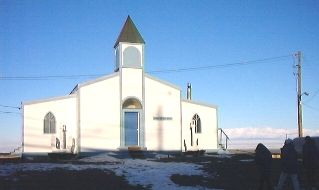
This is to the kids in Cindy's class, including Cindy and Ally who are interested in what I do and the place I live.
A Sunday in my life on the ice, the one day a week we get off work.

It's Sunday morning and for the first time since I have been in Antarctica, I decide to go to church. It's called Chapel of the Snows. This is the 3rd building as the other two burned down years ago. Its a multi-denominational church and the people are very friendly. During the winter, the staff at Mactown and Scott Base run it, and during the summer several priests come down and run it. Like I said, it was the first time I had been inside the church. Although I don't have any strong faith in religion, I do personally believe in God, and once every few years I decide to talk to him in a church on a Sunday, instead of wherever and whenever I feel like it. It started at 10.30 AM and finished at 11.30 AM. Today we also had to wind our clocks back because daylight saving in NZ ended today 15-3-98. The Americans follow our time zone down here and so they had to do the same.
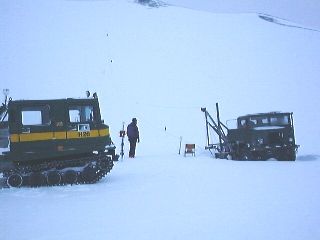
When church was over, we all went to the Mactown Galley and had brunch; a very tasty feed !! Then I went back to Scott Base, phoned up my wife back home in New Zealand for our weekly half hour chat (we have email as well but it's always nice to hear other people's voices). Then Mike and Kevin (mork is his nick name) and I headed for the ski field. It was good snow and I quickly improved my technique of building up enough downhill speed before crashing head first into the snow with the skies flailing aimlessly around my ears. Nothing beats it for building up your confidence in a given sport.
In the photo you will see the Haglands which we used to get there with (its about 3miles form Scott Base) and to the right is the old truck, which has been converted into a ski tow. If you look really hard at the photo you will see the rope coming in the top and out the bottom. The rope goes around the special wheel hub a few times and then back out. The wheel is allowed to spin freely as if you where to lift the rear axle of you car then put it in gear. We then use special (nut cracker) wire loop devices to hold onto the rope as it pulls us up the hill. When I get a better photo I will put it in, in place of this poor quality one.
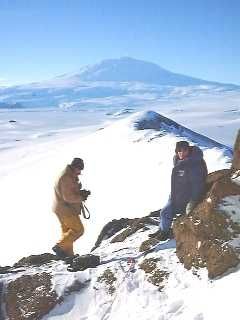
The temperature was about -20 degrees Centigrade which was okay, but then the wind got up to around 20 knots, and the fun went away. I think it brought the temp down to about -50 Deg C wind-chill (at a guess). So we decided we had been there long enough and we packed up, then drove up to castle rock. We parked the Haglands at the bottom then climbed to the top of the hill. In the picture we are about half way up the hill, a bit surprising, but it wasn't any warmer at the top of the hill either, so we came down again and drove the Haglands home. We refueled it and then put our skis and other stuff away. We have to make sure that all the vehicles are fueled and ready to go at all times. This is not a place to run out of fuel in the middle of nowhere.

It was about 4.30 by the time we got home and there was still a bit of sun in the sky so Chris (the mechanic) and I drove straight out to Willies air field. The air field has been packed up for the winter but I wanted to get a digital picture of the big Terra Bus (the name on the side is IVAN THE TERRA BUS) that the Americans use for transporting large quantities of people at a time. Its not required during the winter so they just park it out at the field and put blocks under it so that if the tires go flat they wont distort the shape of the tire in the extreme cold. The tires are big to spread the weight of the bus over a large surface area, so it doesn't sink into the snow.

It was about 5.30 PM by the time I got the photos I wanted and Chris had taken a small bit of video. In this photo you will see what we are looking at through the windscreen of the vehicle as we drive back to base in the Ute (Toyota 4 w drive). If you look to the left of the hills there is a small peek of Observation hill and Mactown is just on the other side of the saddle. Scott Base is at approximately 11 o'clock of straight ahead. You can't see it for the distance and shadow but its almost directly under the peak of the large hill in the center, on the shore. The hill is called Crater Hill and one or two of use run about half way up and back for a bit of exercise every now and then (hence the name coolrunner). We also run half way out to Willies field and back, and during the next couple of days we will run the whole distance.

After being out skiing, I decided to take a plunge in the Scott Base spa pool. It runs at about 45 degrees Centigrade and is just soooo nice to relax into after a hard work out, or a day out in the cold weather. In this shot you can see Mike (with the moustache) a couple of other Americans and Mork. Mork is a bit camera shy, so he ducked under the water. At present he looks like a small barren atoll in the middle of the pacific ocean. After all that, I had dinner and came up to the computer room to do this page for my web site. I hope you kids are now more aware of what I do in a day; very little if I can help it, so I'm told. I do try to get through the work I have to do, and I always try to help other people if I can.
Now onto all the questions you sent me
Question 1
Clothing: We use a variety of clothing, depending on the weather outside. I will go into it in more detail in another section of the web page at a later date. We usually walk around inside the base in t-shirts and jeans or track pants. When we go out into the cold we need to put on our cold weather jackets and maybe even leggings. If we are not out in the cold for too long then we don't put as much on but if we are going out on a field trip for a few hours or more we are very careful that we put on thermal underwear, insulated leggings, a couple of warm shirts or a polar fleece and a big, heavy insulated jacket made from windproof material and filled with fine goose down to keep us warm. If any of you have ever skied, it would be very similar gear except that ours will keep us alive at -60 degrees centigrade. We also use very well-insulated gloves and big insulated boots. Most of our non-windproof clothing is polarfeece material which is nice and light and flexible. We also use some Kahart overalls and jackets in milder weather when we need something that we don't care if it gets dirty. The last thing you want to do is get you extreme weather clothing dirty as it loses its insulation qualities. You asked: Are we warm enough? Yes, we are. In all our cloths we are as snug as bugs in a rug.
Question 2
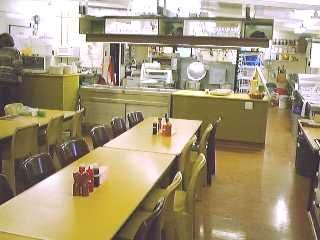
Where do we get our food? It has to be flown or shipped in to
us during the summer, and then we have to make it last right
through the winter unitl we get re-supplied the next summer. The
fresh vegetables and stuff will only last a total of 3 months
maximum (our winter is 8 months long.). So we quickly run out. We
do have a small hydroponics garden but it doesn't supply enough
and is really only for a small bit of variety every now and then.
As far as we are concerned our food comes from the kitchen(mess),
as it shows in the photo.
Question 3
How did we get to Antarctica? Most people, including myself,
came in on C140 military airplanes. Its also called a Starlifter.
Its a bit bigger than a Hercules, which also come down, and a bit
smaller than a Galaxy (imagine a big 747 airplane landing on sea
ice that's only 2.5 meters thick). Most transport is done by
airplane, but we do get some coming down on ships. Like the oil
tanker, coast guard ice breaker, research vessels, and tourist
ships. Whichever way you get down here, it isn't very comfortable.
They try to pack as much freight and people onto every flight as
possible. I think I heard a rumor that it works out at about $15,000
NZ dollars per person, on average, to get someone here on a plane.
Question 4
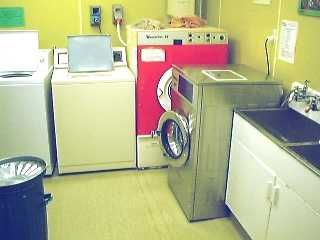
Where do we wash our cloths? In the laundry. Just think of
this place as a mini city. We have most things you would find in
a normal home that houses 75 people. Washing machines
and tumble dryers.
Question 4
What kind of things do I fix? Anything electrical and anything
else that nobody else wants to fix themselves. Everything from
dishwashers, fridge's and washing machines, to electric power
tools switch boards, fire alarms generators and breathing
apparatus (for the fire fighting equipment), plus much, much more!!
You name it (even if it resembles electrical) and Ill have a go
at fixing it. My work in the past has mainly been fixing large
industrial machines and other smaller equipment such computers
and other stuff, I am not afraid to try most things.
Question 5
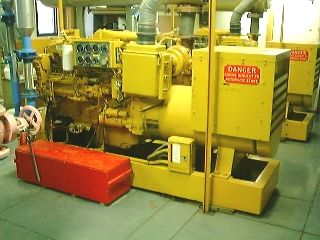
Where do I get the electricity? In the picture you will see
two of our three- phase 400 volt generators. Each one can produce
up to about 180 KVA (350amps) per phase. We only use one
generator at any one time and we have another one of them in a
lower part of the base, just in case anything happened to these
ones. The front part is a big engine (the bit with all the dials
on it) and the other plain end is the generator side. In America
the power is 110 volts but we use 230volts. The generators are
very reliable and we try to look after them as best we can. The
motors are starting to get a bit old and will soon need either
replacing or rebuilding with new parts. The power may fail about
3 to 5 times a year depending on silly little faults that happen,
but it is not normally off for more than a few minutes at a time,
unless someone like myself needs to turn off the generators to do
work on the main switch board. Even then the base cannot be off
to long, or else the base gets to cold and pipes would start to
freeze.
Question 7
There are no children in Antarctica. No mater how infantile some
people act they, are usually older than 20years, at least. Also
no old people, usually !! You only get to come down to Antarctica
if you have a purpose and kids don't normally have a trade or
scientific reason to be down here. The only exception to the rule
is the tourist ships that come down here during the later part of
summer, but they are only here for a short time and I only saw
one kid who would have been about 7 or 8years old running around
Scott Base (with his parents) for about 20minutes ,before they
flew back to their ship on the helicopter.
Question 8
Wild life on Ross Island, We have penguins and seals, the odd
Killer Whale and Minky Whale also go past. Most of the wild life
is at the other end of the island around the penguin rookery's.
There you will find Adele penguins (don't think I spelt it right
but it will do for now) and a few Emperor penguins. (Adele
penguins are very funny but they don't let you get to close to
them . The Emperor on the other hand is very inquisitive and will
come right up close and inspect you. Seals are normally the
Weddel seals and they are often found lounging around on the sea
ice at the front of Scott Base. There are also a few leopard
seals but they don't normally come around this part of the island.
Penguins can live in very cold climates and I think from memory that the Emperor's will live in inland rookery's where the temperature can drop to -50 degrees Celsius, and then there is the strong wind chills that can take the actual temperature even lower. Normally the penguins don't die from the cold if they are well feed, but if they are trying to rear chicks they might become weakened from prolonged starvation.
Question 9
What do we do for a living.. Take a look at the page which gives
you a list of the winter crew. Its on the first index page that
you see. Wintercrew 1997 to 1998, it says it all there.
Question 10
What do we use for transport. Take a look at the Page on
transport. Its not complete yet but it will give you an idea.
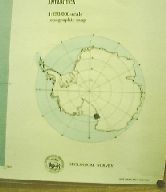
I almost forgot to show you this picture of where Scott Base is in Antarctica. Its where the little black square is. If you follow the closest latitude line away from Antarctica you will come to New Zealand.
Dont forget to visit the pages on wildlife and adventure, there
is stuff in there you will find interesting.
Cheers
Ray
www.geocities.com/coolrunnernz/
9-3-01
Re-Edited by Shirley Baston Fred - [email protected] - ICQ #15167279